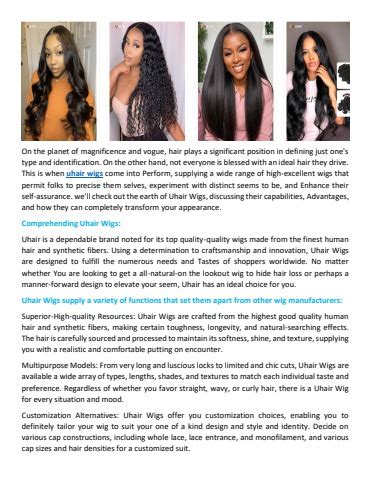Introduction
Wigs have become an integral part of women’s fashion and beauty regimens, providing versatile ways to express oneself, transform appearances, and address hair-related concerns. From medical conditions to personal preferences, wigs offer a wide range of options for women of all ages and backgrounds.

Understanding the Wig Market
The global wig market is projected to reach a staggering $13.6 billion by 2029, driven by growing demand for natural-looking, high-quality wigs. According to the American Cancer Society, over 1.3 million new cancer cases are diagnosed in women each year, many of whom experience hair loss as a result of treatment. This has led to a significant increase in the demand for wigs for medical purposes.
Benefits of Wearing a Wig
Beyond medical applications, wigs offer numerous benefits for women:
-
Style versatility: Wigs allow women to experiment with different hairstyles, lengths, colors, and textures, giving them the freedom to update their look instantly.
-
Hair growth: For women experiencing hair loss due to medical conditions or treatments, wigs provide a natural-looking cover while hair regrows.
-
Confidence boost: Wigs can enhance self-esteem and confidence by giving women the appearance of a full head of healthy hair.
-
Convenience: Wigs are convenient and easy to wear, eliminating the need for time-consuming and expensive salon visits.
Types of Wigs
There are numerous types of wigs available, each with unique characteristics and benefits:
-
Synthetic wigs: Made from artificial fibers, synthetic wigs are affordable, easy to maintain, and provide a wide range of color and style options.
-
Human hair wigs: Crafted from real human hair, human hair wigs offer a natural look and feel, making them more expensive than synthetic wigs.
-
Lace wigs: Lace wigs have a delicate lace base that is applied to the scalp, creating a realistic illusion of a natural hairline.
-
Monofilament wigs: Monofilament wigs feature a thin, breathable mesh base that provides a comfortable and undetectable look.
-
Medical wigs: Designed specifically for cancer patients and others experiencing hair loss, medical wigs are made from soft, hypoallergenic materials for added comfort.
Factors to Consider When Choosing a Wig
Choosing the right wig requires careful consideration of the following factors:
-
Face shape: The shape of your face should guide your wig selection. Oval faces can wear most styles, while round faces look best with longer, layered wigs.
-
Skin tone: Your skin tone can influence the color of the wig you choose. Warm skin tones complement warm-toned wigs, while cool skin tones look best with cool-toned wigs.
-
Hair texture: Matching the texture of your natural hair to the wig can create a more natural look. If your hair is curly, opt for a wig with similar curls.
-
Budget: Wigs vary in price depending on the material, type, and quality. Consider your budget and set a limit before you start shopping.
Wig Care and Maintenance
Proper care and maintenance are essential to extend the lifespan of your wig and keep it looking its best:
-
Washing: Synthetic wigs can be washed with cold water and a mild shampoo. Human hair wigs should be washed less frequently with a shampoo specifically designed for human hair extensions.
-
Styling: Heat styling tools can damage wigs, so use them sparingly and apply a heat protectant spray before using heat.
-
Storage: When not in use, store your wig on a wig stand or in a wig box to prevent tangles and dust accumulation.
Styling Tips for Wigs
With proper styling, wigs can enhance your appearance and blend seamlessly with your natural features:
-
Use hairspray: Hairspray helps keep wigs in place and prevents flyaways. Choose a hairspray with a light hold to avoid a crispy or crunchy look.
-
Accessorize: Accessories such as headbands, scarves, and hats can add style and personality to your wig. Experiment with different accessories to find what works best for you.
-
Trim the bangs: If the bangs on your wig are too long or uneven, trim them to frame your face and enhance your natural features.
-
Add volume: Use a volumizing spray or hair mousse to add volume to your wig and create a fuller look.
Conclusion
Wigs have become an essential tool for women seeking versatility, confidence, and hair solutions. By understanding the different types of wigs, considering personal factors, and following proper care and maintenance guidelines, women can harness the transformative power of wigs to enhance their style, boost their confidence, and address hair-related concerns effectively.
